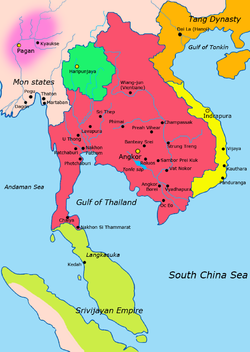Khmer empire
| Khmer Empire | ||||||||||||||
|
កម្វុជទេឝ ख्मेर साम्राज्य Kambujadesa |
||||||||||||||
|
||||||||||||||
| Capital |
Mahendraparvata (early 9th cent.) Hariharalaya (9th cent.) Yasodharapura (late 9th to early 10th cent.) Angkor (10th to 15th cent.) |
|||||||||||||
| Languages |
Old Khmer Sanskrit |
|||||||||||||
| Religion |
Hinduism Mahayana Buddhism Theravada Buddhism |
|||||||||||||
| Government | Absolute monarchy | |||||||||||||
| King | ||||||||||||||
| • | 802–850 | Jayavarman II | ||||||||||||
| • | 1113–1150 | Suryavarman II | ||||||||||||
| • | 1181–1218 | Jayavarman VII | ||||||||||||
| • | 1393–1463 | Ponhea Yat | ||||||||||||
| Historical era | Middle Ages | |||||||||||||
| • | Enthronement of Jayavarman II | 802 | ||||||||||||
| • | Siamese invasion | 1431 | ||||||||||||
| Area | ||||||||||||||
| 1,200,000 km² (463,323 sq mi) | ||||||||||||||
| Population | ||||||||||||||
| • | 1150 est. | 4,000,000 | ||||||||||||
|
||||||||||||||
| Today part of |
|
|||||||||||||
The Khmer Empire (Khmer: ចក្រភពខ្មែរ), officially the Angkor Empire (Khmer: ចក្រភពអង្គរ), the predecessor state to modern Cambodia ("Kampuchea" or "Srok Khmer" to the Khmer people), was a powerful Hindu-Buddhist empire in Southeast Asia. The empire, which grew out of the former kingdoms of Funan and Chenla, at times ruled over and/or vassalised most of mainland Southeast Asia.
Its greatest legacy is Angkor, in present-day Cambodia, which was the site of the capital city during the empire's zenith. The majestic monuments of Angkor—such as Angkor Wat and Bayon—bear testimony to the Khmer Empire's immense power and wealth, impressive art and culture, architectural technique and aesthetics achievements, as well as the variety of belief systems that it patronised over time. Satellite imaging has revealed that Angkor, during its peak in the 11th to 13th centuries, was the largest pre-industrial urban centre in the world.
The beginning of the era of the Khmer Empire is conventionally dated to 802 CE. In this year, King Jayavarman II had himself declared chakravartin ("king of the world", or "king of kings") on Phnom Kulen. The empire ended with the fall of Angkor in the 15th century.
The history of Angkor as the central area of settlement of the historical kingdom of Kambujadesa is also the history of the Khmer kingdom from the 9th to the 13th centuries.
From Kambuja itself — and so also from the Angkor region — no written records have survived other than stone inscriptions. Therefore, the current knowledge of the historical Khmer civilisation is derived primarily from:
...
Wikipedia

